Ofada rice, along with its sauce, is a meal traditional to South West Nigeria. There is a town in Ogun State known as Ofada.
This delicacy is accompanied with the famous ofada stew which consists of palm oil, unripe pepper, onion and locust bean as the main ingredients. It is the local variety of rice with its own unique flavour.
Ofada Rice
The delicacy used to be the rejected and forbidden meal. It was isolated and left for only the poor; but now it is the delight of most social gatherings. These days, no party is complete without it; in fact people are “obsessed” with the meal.
According to Itoro Effiong-Bright, a professional cook and the ‘Chef’ Executive Officer of Ibomsoups, “the ofada rice is much healthier than the regular parboiled or polished rice”.
She added that “Nigerians are now beginning to pay more attention to their health and nutrition”.
“People are getting tired of the regular parboiled or polished rice; they want to try something different from what they had been having, and that is where the ofada comes in,” she stressed.
“In recent times, the method of cooking ofada rice is now modern, and the packaging has been modified from the regular dried fish to assorted meat, which gives people more to chew in the meal.”
With the current awareness of the risk of consuming ‘junk’ meals, Nigerians are focusing on local foods, and are taking pride in their tradition. People are now more enlightened that local foods are not just healthier but also delicious.
Gone are the days when pebbles in local rice varieties made eating a horror. Because picking and washing the rice were a herculean task, meal time turned to a time of cracking shingles with the molars. Ofada rice is now more refined and processed. It is now a priced meal, so muchthat the regular fried and jollof rice are left for the children.
Though so many people eat ofada rice because of its taste, some eat it or are confined to it based on health issues. The meal has been linked to protection against atherosclerosis, ischemic stroke, diabetes, insulin resistance, and obesity.
In addition to the chain of nutrients in ofada’s dietary fibre, the whole grain store includes a wide variety of additional nutrients and phytochemicals that reduce the risk of cardiovascular disease. Compounds in whole grains that have cholesterol-lowering properties include polyunsaturated fatty acids, oligosaccharides, plants sterols and stanols, and saponins.
Ofada rice is also an important dietary source of water-soluble, fat-soluble, and insoluble anti-oxidants. The long lists of cereal antioxidants include vitamins E, tocotrieonols, selenium, phenolic acids, and phytic acid.
These multi-functional antioxidants come in immediate-release to slow-release forms and thus are available throughout the gastrointestinal tract over a long period after being consumed.
So, apart from the condiments used in cooking ofada, the rice itself is also healthy. However nutritious and nourishing the ofada stew, also known as Ayamase may be, some people do not like its unavoidably peppery taste, because it often hurts the mouth and stomach. Abstinence is compulsory for ulcer patients. Some people are also allergic to the locust beans used in its preparation, and that makes them stay away from the delicacy altogether.
















